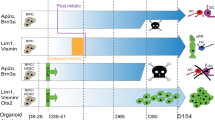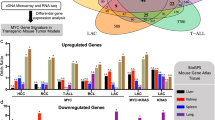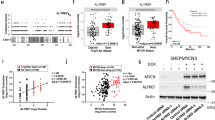Abstract
Maf b-Zip transcription factors are involved in both terminal differentiation and oncogenesis. To investigate this apparent contradiction, we used two different primary cell types and performed an extensive analysis of transformation parameters induced by Maf proteins. We show that MafA and c-Maf are potent oncogenes in chicken embryo fibroblasts, while MafB appears weaker. We also provide the first evidence that MafA can confer growth factor independence and promote cell division at low density. Moreover, using MafA as a model, we identified several parameters that are critical for Maf transforming activities. Indeed, MafA ability to induce anchorage-independent cell growth was sensitive to culture conditions. In addition, the transforming activity of MafA was dependent on its phosphorylation state, since mutation on Ser65 impaired its ability to induce growth at low density and anchorage-independent growth. We next examined transforming activity of large Maf proteins in embryonic neuroretina cells, where they are known to induce differentiation. Unlike v-Jun, MafA, MafB and c-Maf did not show oncogenic activity in these cells. Moreover, they counteracted transformation induced by constitutive activation of the Ras/Raf/MEK pathway. Taken together, our results show that Maf proteins could display antagonistic functions in oncogenesis depending on the cellular context, and support a dual role for Maf as both oncogenes and tumor suppressor-like proteins.
This is a preview of subscription content, access via your institution
Access options
Subscribe to this journal
Receive 50 print issues and online access
$259.00 per year
only $5.18 per issue
Buy this article
- Purchase on Springer Link
- Instant access to full article PDF
Prices may be subject to local taxes which are calculated during checkout








Similar content being viewed by others
References
Benkhelifa S, Provot S, Lecoq O, Pouponnot C, Calothy G, Felder-Schmittbuhl MP . (1998). Oncogene 17: 247–254.
Benkhelifa S, Provot S, Nabais E, Eychène A, Calothy G, Felder-Schmittbuhl MP . (2001). Mol Cell Biol 21: 4441–4452.
Blanchi B, Kelly LM, Viemari JC, Lafon I, Burnet H, Bevengut M et al. (2003). Nat Neurosci 6: 1091–1100.
Boersma-Vreugdenhil GR, Kuipers J, Van Stralen E, Peeters T, Michaux L, Hagemeijer A et al. (2004). Br J Haematol 126: 355–363.
Buscà R, Abbe P, Mantoux F, Aberdam E, Peyssonnaux C, Eychène A et al. (2000). EMBO J 19: 2900–2910.
Catling AD, Schaeffer HJ, Reuter CW, Reddy GR, Weber MJ . (1995). Mol Cell Biol 15: 5214–5225.
Chamboredon S, Briggs J, Vial E, Hurault J, Galvagni F, Oliviero S et al. (2003). Oncogene 22: 4047–4061.
Chinenov Y, Kerppola TK . (2001). Oncogene 20: 2438–2452.
Cordes SP, Barsh GS . (1994). Cell 79: 1025–1034.
Fu S, Bottoli I, Goller M, Vogt PK . (1999). Proc Natl Acad Sci USA 96: 5716–5721.
Golde A, Vigier P . (1961). Virology 15: 36–46.
Hale TK, Myers C, Maitra R, Kolzau T, Nishizawa M, Braithwaite AW . (2000). J Biol Chem 275: 17991–17999.
Hideshima T, Bergsagel PL, Kuehl WM, Anderson KC . (2004). Blood 104: 607–618.
Ho IC, Hodge MR, Rooney JW, Glimcher LH . (1996). Cell 85: 973–983.
Hughes SH, Greenhouse JJ, Petropoulos CJ, Sutrave P . (1987). J Virol 61: 3004–3012.
Hurt EM, Wiestner A, Rosenwald A, Shaffer AL, Campo E, Grogan T et al. (2004). Cancer Cell 5: 191–199.
Hussain S, Kilbey A, Gillespie DA . (1998). Cell Growth Differ 9: 677–686.
Johnson R, Spiegelman B, Hanahan D, Wisdom R . (1996). Mol Cell Biol 16: 4504–4511.
Kataoka K, Han SI, Shioda S, Hirai M, Nishizawa M, Handa H . (2002). J Biol Chem 277: 49903–49910.
Kataoka K, Fujiwara KT, Noda M, Nishizawa M . (1994). Mol Cell Biol 14: 7581–7591.
Kawauchi S, Takahashi S, Nakajima O, Ogino H, Morita M, Nishizawa M et al. (1999). J Biol Chem 274: 19254–19260.
Kelly LM, Englmeier U, Lafon I, Sieweke MH, Graf T . (2000). EMBO J 19: 1987–1997.
Kim JI, Ho IC, Grusby MJ, Glimcher LH . (1999a). Immunity 10: 745–751.
Kim JI, Li T, Ho IC, Grusby MJ, Glimcher LH . (1999b). Proc Natl Acad Sci USA 96: 3781–3785.
Kuehl WM, Bergsagel PL . (2002). Nat Rev Cancer 2: 175–187.
Kurschner C, Morgan JI . (1995). Mol Cell Biol 15: 246–254.
Lecoin L, Sii-Felice K, Pouponnot C, Eychène A, Felder-Schmittbuhl MP . (2004). Gene Exp Patterns 4: 35–46.
Lloyd A, Yancheva N, Wasylyk B . (1991). Nature 352: 635–638.
Manzanares M, Cordes S, Ariza-McNaughton L, Sadl V, Maruthainar K, Barsh G et al. (1999). Development 126: 759–769.
Matsuoka TA, Artner I, Henderson E, Means A, Sander M, Stein R . (2004). Proc Natl Acad Sci USA 101: 2930–2933.
Mears AJ, Kondo M, Swain PK, Takada Y, Bush RA, Saunders TL et al. (2001). Nat Genet 29: 447–452.
Motohashi H, O'Connor T, Katsuoka F, Engel JD, Yamamoto M . (2002). Gene 294: 1–12.
Nishizawa M, Kataoka K, Goto N, Fujiwara KT, Kawai S . (1989). Proc Natl Acad Sci USA 86: 7711–7715.
Nishizawa M, Kataoka K, Vogt PK . (2003). Oncogene 22: 7882–7890.
Ochi H, Ogino H, Kageyama Y, Yasuda K . (2003). J Biol Chem 278: 537–544.
Ogino H, Yasuda K . (1998). Science 280: 115–118.
Olbrot M, Rud J, Moss LG, Sharma A . (2002). Proc Natl Acad Sci USA 99: 6737–6742.
Onodera K, Shavit JA, Motohashi H, Yamamoto M, Engel JD . (2000). EMBO J 19: 1335–1345.
Ostrer H, Beebe DC, Piatigorsky J . (1981). Dev Biol 86: 403–408.
Papin C, Denouel-Galy A, Laugier D, Calothy G, Eychène A . (1998). J Biol Chem 273: 24939–24947.
Peyssonnaux C, Provot S, Felder-Schmittbuhl MP, Calothy G, Eychène A . (2000). Mol Cell Biol 20: 7068–7079.
Pouponnot C, Nishizawa M, Calothy G, Pierani A . (1995). Mol Cell Biol 15: 5563–5575.
Radtke F, Raj K . (2003). Nat Rev Cancer 3: 756–767.
Ring BZ, Cordes SP, Overbook PA, Barsh GS . (2000). Development 127: 307–317.
Schutte J, Minna JD, Birrer MJ . (1989). Proc Natl Acad Sci USA 86: 2257–2261.
Smeal T, Binetruy B, Mercola DA, Birrer M, Karin M . (1991). Nature 354: 494–496.
Sii-Felice K, Pouponnot C, Gillet S, Lecoin L, Girault J-A, Eychène A et al. (2005). FEBS Lett 579: 3547–3554.
Swain PK, Hicks D, Mears AJ, Apel IJ, Smith JE, John SK et al. (2001). J Biol Chem 276: 36824–36830.
Swaroop A, Xu JZ, Pawar H, Jackson A, Skolnick C, Agarwal N . (1992). Proc Natl Acad Sci USA 89: 266–270.
Van Dam H, Castellazzi M . (2001). Oncogene 20: 2453–2464.
Vandel L, Montreau N, Vial E, Pfarr CM, Binetruy B, Castellazzi M . (1996). Mol Cell Biol 16: 1881–1888.
Vinson C, Myakishev M, Acharya A, Mir AA, Moll JR, Bonovich M . (2002). Mol Cell Biol 22: 6321–6335.
Watson JE, Doggett NA, Albertson DG, Andaya A, Chinnaiyan A, van Dekken H et al. (2004). Oncogene 23: 3487–3494.
Yoshida K, Kim JI, Imaki J, Hiromi I, Nishi S, Matsuda H et al. (2001). Curr Eye Res 23: 116–119.
Yoshida T, Yasuda K . (2002). Genes Cells 7: 693–706.
Acknowledgements
We thank Marc Castellazzi, Makoto Nishizawa, Andy Catling and Joram Piatigorsky for providing reagents used in this study, and Georges Calothy for critical reading of the manuscript. We also thank Marc Castellazzi for helpful discussions. This work was funded by the Centre National de la Recherche Scientifique, the Institut Curie, and by grants from the Ligue Nationale Contre le Cancer (Comité de l'Essonne), the Association pour la Recherche sur le Cancer (grant 3534) and Retina France. KSF was supported by a fellowship from the Association pour la Recherche sur le Cancer. IH was supported by a fellowship from the Ligue Nationale Contre le Cancer (Comité de l'Oise).
Author information
Authors and Affiliations
Corresponding authors
Rights and permissions
About this article
Cite this article
Pouponnot, C., Sii-Felice, K., Hmitou, I. et al. Cell context reveals a dual role for Maf in oncogenesis. Oncogene 25, 1299–1310 (2006). https://doi.org/10.1038/sj.onc.1209171
Received:
Revised:
Accepted:
Published:
Issue Date:
DOI: https://doi.org/10.1038/sj.onc.1209171
Keywords
This article is cited by
-
The role and regulation of Maf proteins in cancer
Biomarker Research (2023)
-
Integrative analysis reveals early epigenetic alterations in high-grade serous ovarian carcinomas
Experimental & Molecular Medicine (2023)
-
MAFb protein confers intrinsic resistance to proteasome inhibitors in multiple myeloma
BMC Cancer (2018)
-
MAF mediates crosstalk between Ras-MAPK and mTOR signaling in NF1
Oncogene (2014)
-
GSK3-mediated MAF phosphorylation in multiple myeloma as a potential therapeutic target
Blood Cancer Journal (2014)



